On This Page:
Neuroscience is the branch of science concerned with studying the nervous system. It is a multidisciplinary field integrating numerous perspectives from biology, psychology, and medicine. It consists of several sub-fields ranging from the study of neurochemicals to behavior and thought.
For example, cognitive neuroscience is the scientific study of the influence of brain structures on mental processes, done using brain scanning techniques such as fMRI.
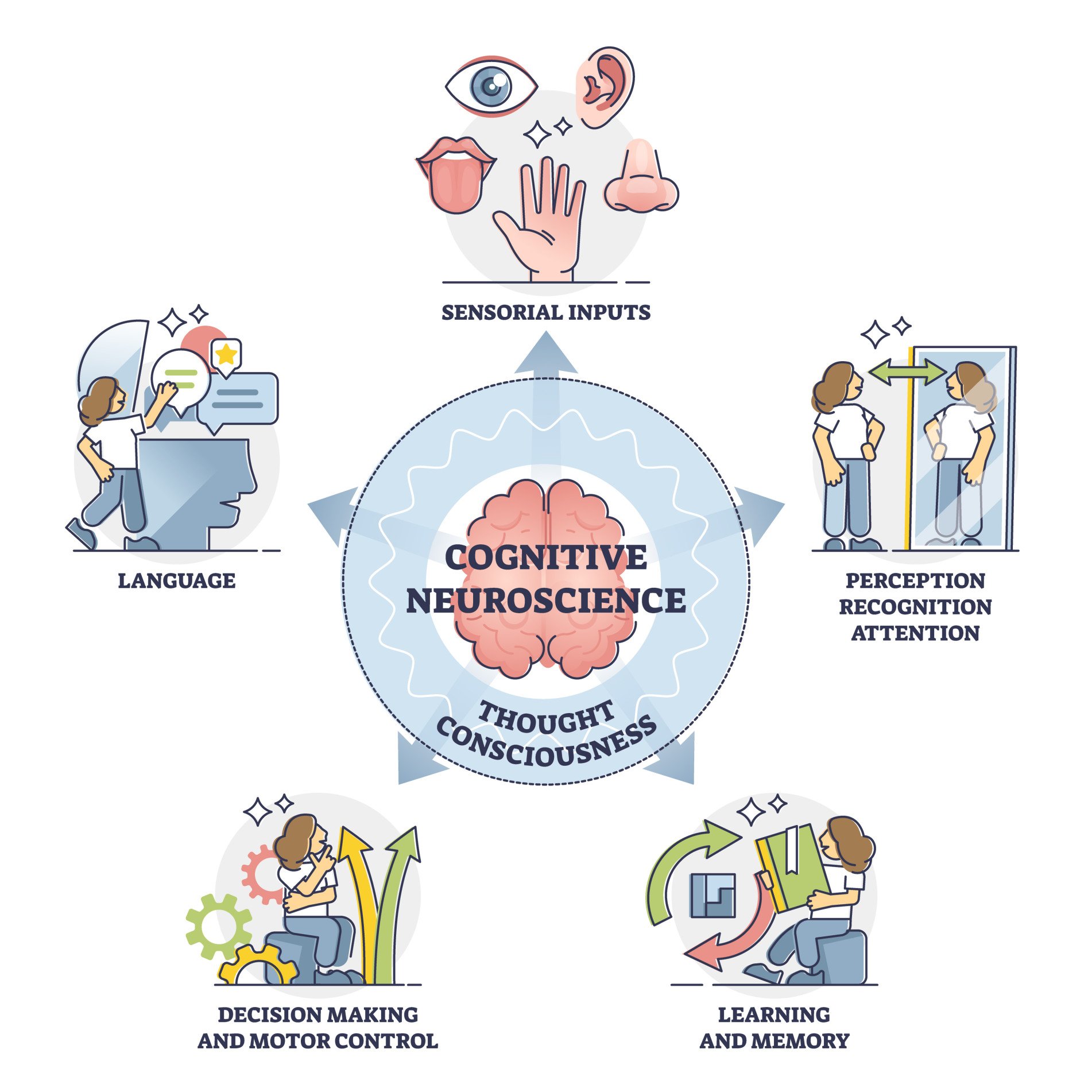
What is Cognitive Neuroscience?
Cognitive neuroscience aims to discover how brain structures influence how we process information and map mental cognitive functions to specific areas of the brain. This is done using brain imaging techniques such as fMRI and PET scans.
The earliest historical roots of neuroscience can be traced to the ancient Egyptians, who practiced trephination — drilling a hole into the skull to treat brain and/or mental disorders — and possessed some knowledge about the symptoms of brain damage (Mohamed, 2008).
Much later, the invention of the microscope and the use of staining procedures led to the discovery of individual neurons (cells of the nervous system) by Santiago Ramón y Cajal in the late 1890s, setting the stage for the modern study of the nervous system (Guillery, 2004). The emergence of neuroscience as a distinct field began in the 20th century, pioneered by David Rioch, Francis O. Schmitt, and Stephen Kuffler (Cowan et al., 2000).
The branches of neuroscience are primarily defined by their scales of analysis — that is, the perspectives from which they analyze the nervous system. Molecules in the nervous system form the basis for neuronal function and communication, which is the focus of molecular neuroscience.
These molecular processes give rise to larger-scale cellular functions within neurons — such as those involved in neural signaling — which is the focus of cellular neuroscience. Such functions enable complex systems of communication between neurons, which is the focus of systems neuroscience. Finally, these systems ultimately underlie thought and behavior, which is the focus of cognitive and behavioral neuroscience.

The scientific study of the nervous system provides crucial insights into the workings of the mind and brain, and is thus indispensable to psychology. Neuroscience allows us to understand the many workings of the mind as operating through networks of neural connections, just as computers operate through electrical connections.
By studying how these neural connections work, we can better comprehend normal human cognition and disease—i.e., when these neural connections go awry.
The Society for Neuroscience (2015) lists the following as the field’s “core concepts”:
- The brain is the body’s most complex organ.
- Neurons communicate using both electrical and chemical signals.
- Genetically determined circuits are the foundation of the nervous system.
- Life experiences change the nervous system.
- Intelligence arises as the brain reasons, plans, and solves problems.
- The brain makes it possible to communicate knowledge through language.
- The human brain endows us with a natural curiosity to understand how the world works.
- Fundamental discoveries promote healthy living and the treatment of disease.
Neurons and Synapses
Neurons are the basic cellular units that constitute the nervous system. Humans possess approximately 100 billion neurons. An individual neuron generally consists of a soma (cell body), dendrites, and axons.
The soma contains the cell’s nucleus (where its DNA is stored) and produces proteins necessary for the neuron’s function.
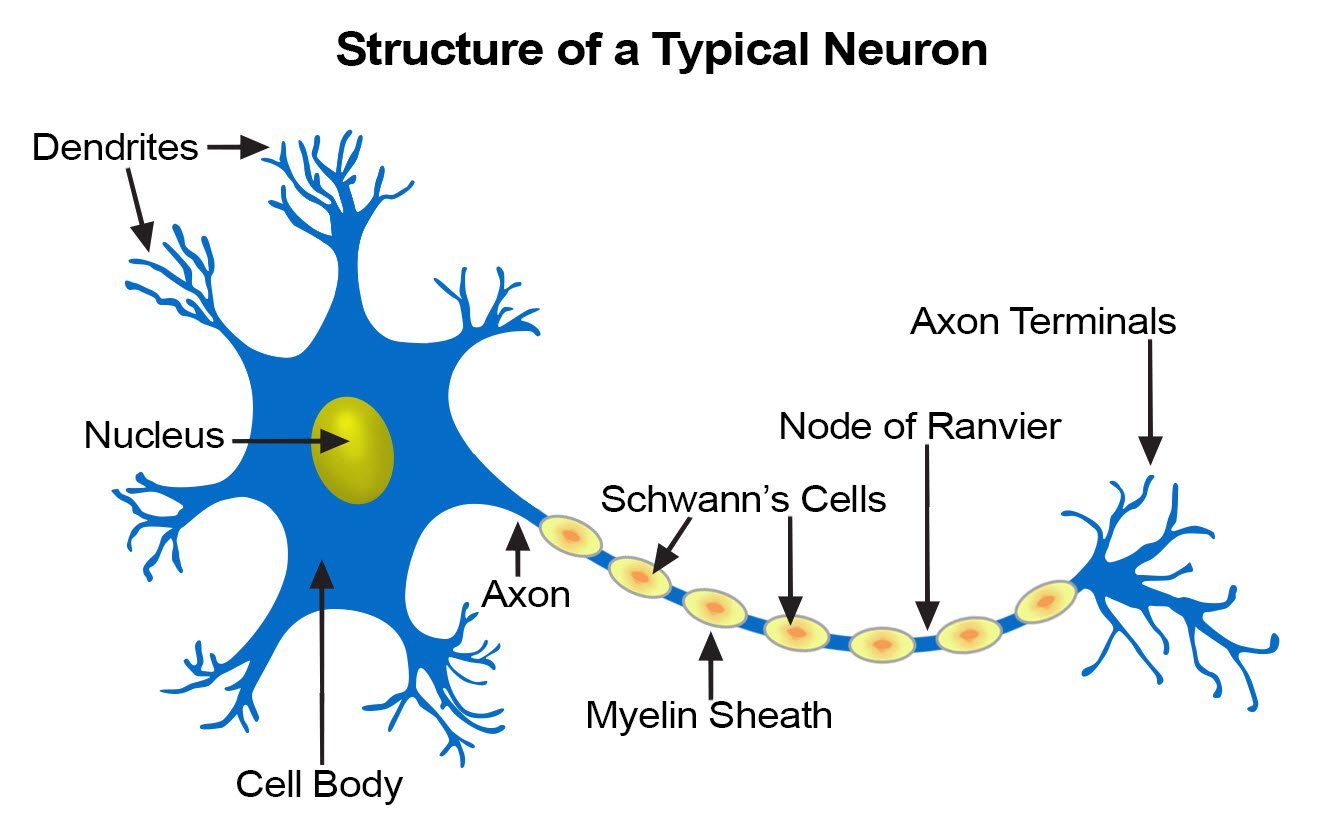
Extending out from the soma are dendrites, which are branch-like structures that form connections with other neurons from which they receive and process electrical signals. Finally, an axon projects out from the other end of the soma, producing and carrying an electrical signal to other neurons.
Each neuron usually only contains one axon, although the structure may be branched following the initial projection from the soma (Woodruff, 2019).
The electrical signals carried by axons and transmitted to dendrites are called action potentials. Neurons are electrical devices — they contain channels that allow positive and negative ions to pass from outside to inside the cell or vice versa, which gives rise to an electrical potential concerning a cell’s membrane (the barrier around the outside of a cell).
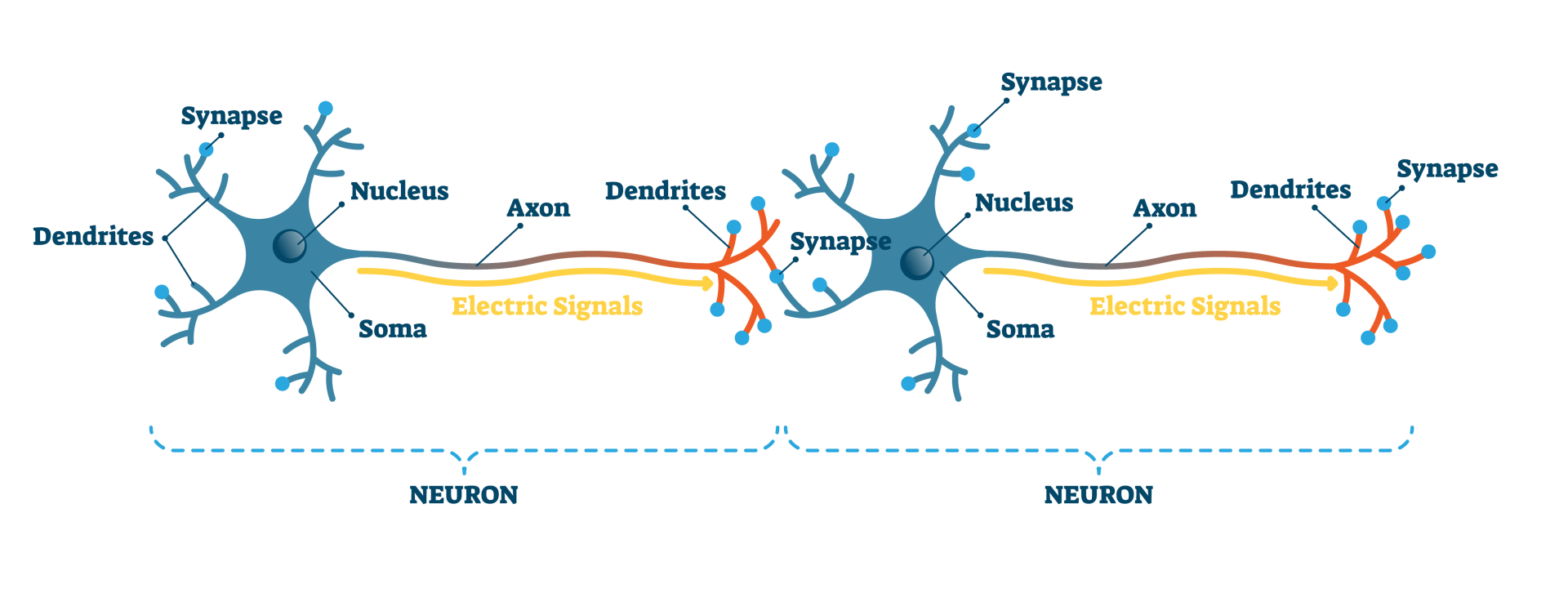
By default (when neurons are “at rest”), there is a more negative charge on the inside of the cell than outside, giving rise to a resting membrane potential of -70 millivolts. However, this electrical potential constantly changes in response to inputs from other cells, which cause ions to flow in or out of the cell.
Some of these inputs are “excitatory,” meaning that they make the cell’s membrane potential less negative (for example, by causing positive ions to flow into the cell), while others are “inhibitory,” meaning that they make the cell’s membrane more negative.
If a neuron receives enough excitatory inputs and not too many inhibitory inputs, its membrane potential will go above what is known as the “action potential threshold” (approximately -50 millivolts), and an action potential will occur.
Electrically, action potentials are brief but dramatic spikes in a neuron’s membrane potential. Neuroscientists often refer to action potentials simply as “spikes.”
When a neuron’s membrane potential passes the action potential threshold, it triggers the opening of what is known as voltage-gated sodium channels, which allow positively charged sodium ions to pass into the cell.
This causes the cell’s membrane potential to rapidly become more positive, leading to a spike. This signal then rapidly travels down the length of the neuron’s axon, because the spike itself causes farther down voltage-gated sodium channels to open as well — and so on and so forth.
Finally, the action potential reaches the end of the axon, and the neuron passes this signal along to other neurons.
Neurons communicate with one another through structures called synapses. A single synapse consists of a presynaptic terminal, a synaptic cleft, and a postsynaptic terminal.
Once an action potential reaches the end of a neuron’s axon, it reaches the presynaptic terminal, which causes neurotransmitters to be released from the cell. These neurotransmitters are released into the synaptic cleft, a small (20-40nm) gap between the pre-and postsynaptic terminals.
The neurotransmitters then travel across the synaptic cleft and activate neurotransmitter receptors on the postsynaptic terminal. When these receptors are activated, they cause positive or negative ions to flow into the postsynaptic neuron, resulting in excitation or inhibition, respectively.
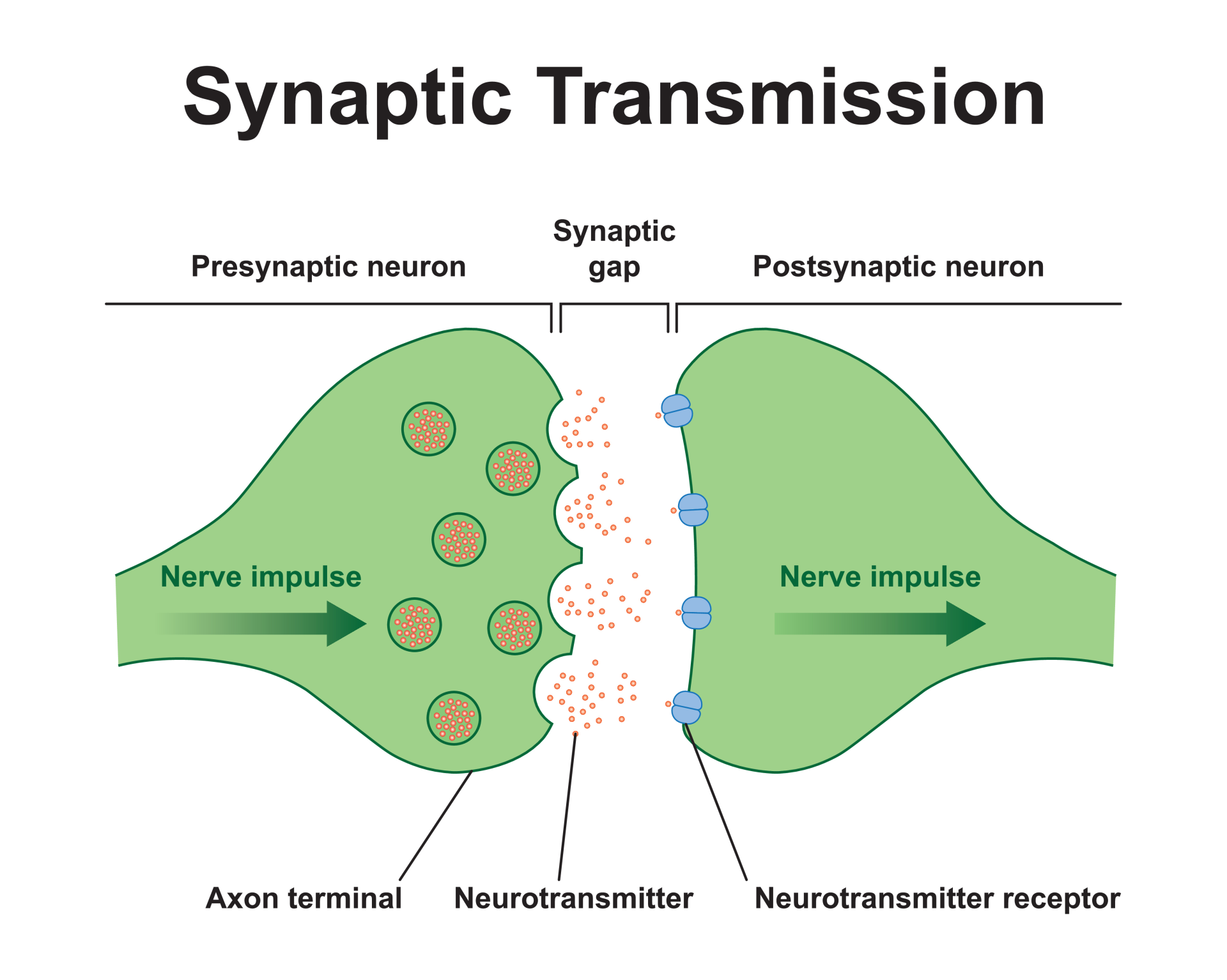
When neurotransmitters act on receptors to cause positive ions to flow into the postsynaptic neuron, it is called excitation because the neuron is brought closer to its action potential threshold and therefore becomes more likely to fire.
Conversely, when neurotransmitters act on receptors to cause negative ions to flow into the postsynaptic neuron, it is called inhibition because the neuron is brought further away from its action potential threshold and therefore becomes less likely to fire.
As a result, some neurotransmitters are referred to as excitatory neurotransmitters (since their action on receptors causes excitation), while others are referred to as inhibitory neurotransmitters.
Common excitatory neurotransmitters include glutamate and dopamine; common inhibitory neurotransmitters include GABA and glycine. Some neurotransmitters, such as serotonin, can be either excitatory or inhibitory depending on the type of receptor it acts upon.
The Nervous System
Our nervous system comprises billions of neurons, all firing action potentials and communicating with each other through synapses.
These networks of neurons ultimately give rise to larger structures that perform specialized functions. By studying the anatomy of the nervous system, we can begin to understand how it divides up its many tasks.
The most important anatomical division of the nervous system is between the central nervous system and the peripheral nervous system. The central nervous system consists of the brain and the spinal cord, and the peripheral nervous system consists of the nerves throughout the body that communicates with the central nervous system.
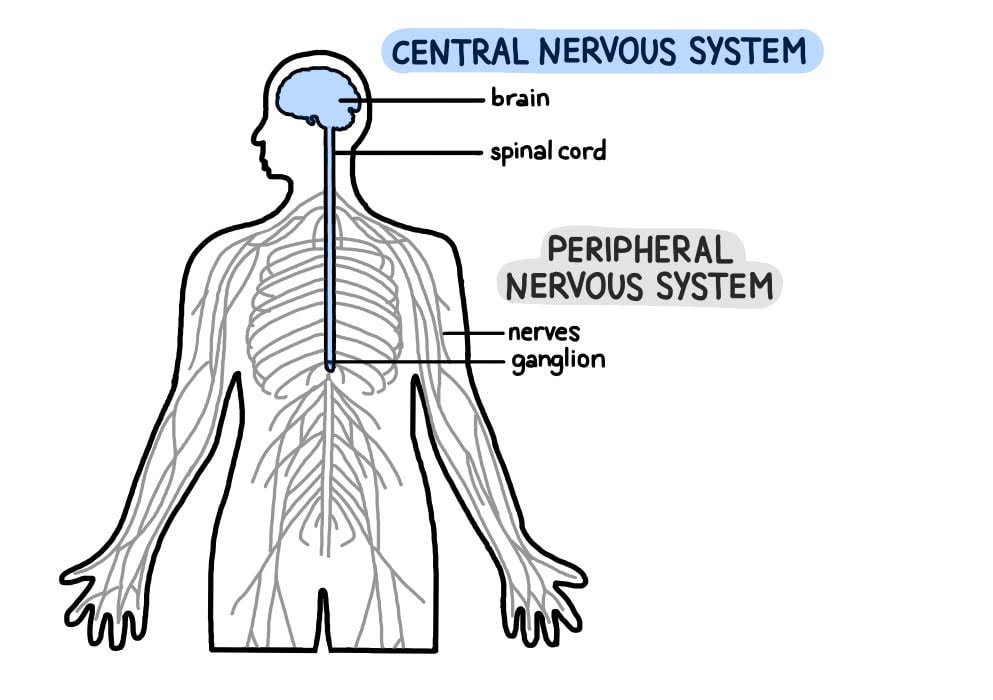
The central and peripheral nervous systems act together to interpret sense data and initiate movement (Sukel, 2019). Sensory information is sent from the peripheral nerves to the spinal cord and then relayed to the brain; motor information travels from the brain down to the spinal cord and then ultimately to the muscles via the peripheral nerves.
The brain itself consists of three parts: the brainstem, the cerebellum, and the cerebral cortex. The brainstem primarily controls so-called “autonomic” functions, meaning unconsciously regulated bodily functions, such as heart rate and breathing. The cerebellum is next to the brainstem and controls balance and movement coordination.
Finally, the cerebral cortex lies above the brainstem and cerebellum and is what most people think of when they think of the brain — it is responsible for the perceptual and cognitive functions that make up our mental lives (Sukel, 2019).
The cerebral cortex, in turn, is divided into two hemispheres and four lobes. A bridge of neural fibers connects the right and left hemispheres called the corpus callosum.
Contrary to popular belief, most cognitive processes are associated with both hemispheres of the cerebral cortex (i.e., the right side is not more “creative” and the left side more “analytical”). However, one exception is that most neural structures related to language reside in the left hemisphere (Sukel, 2019).
In addition to the two hemispheres, the cerebral cortex is also divided into four lobes: the occipital lobe, the temporal lobe, the parietal lobe, and the frontal lobe. The occipital lobe is located toward the back of the brain and is mostly responsible for processing visual information. The temporal lobe is located behind the forehead temples and largely deals with sound information (including language) and some aspects of memory.
The parietal lobe is located above the ear and mainly processes sensory, touch, and spatial information. Lastly, the frontal lobe (the largest lobe) is located above the eyes in the front of the cortex. It is responsible for higher-level cognitive functions such as reasoning, decision-making, and planning.
It is thought that our highly developed frontal cortex separates humans from primate ancestors (Sukel, 2019).
Each lobe contains two distinct types of neural tissue: gray matter and white matter. Gray matter appears gray in color and comprises neurons’ somas, dendrites, and non-neuron supporting cells. White matter is white in color and comprises neurons’ axons, which serve to form connections between areas in the brain.
The white color results from myelin, a fatty substance wrapped around axons to enable them to send signals more efficiently (Sukel, 2019).
The brain also contains numerous smaller regions with more specific functions. Important regions include:
- Hypothalamus — the control center of autonomic functions such as body temperature and blood pressure, as well as behaviors like hunger, thirst, and sex drive.
- Pituitary gland — connected to the hypothalamus, regulates the endocrine system, secreting hormones involved in sexual development, bone and muscle growth, and stress.
- Thalamus — major “relay station” that regulates information coming and going from the cerebral cortex.
- Basal ganglia — in conjunction with the cerebellum, helps coordinate fine motor movements.
- Amygdala — plays a significant role in emotional response to stimuli.
- Hippocampus — responsible for long-term memory (“Anatomy,” 2018).
Neuroscience and Psychology
The scientific study of the brain is indispensable to the scientific study of the mind. Although neuroscience and psychology focus on different domains, neuroscience deals with the realm of physical properties, while psychology deals with the more abstract realm of the mental.
Our ever-evolving ability to correlate brain states with mental states means that the two disciplines can engage in meaningful dialogue.
Scientists have sought to understand the relationship between the brain and mind in normal and abnormal human cognition. This is the main goal of cognitive neuroscience.
Much research in cognitive neuroscience is done through the use of neuroimaging (which refers to any technology that aids in the visualization of the brain) because it allows us to “look inside” living people’s skulls.
The most common form of neuroimaging used in cognitive neuroscience studies is magnetic resonance imaging (MRI), which uses responses from hydrogen ions in different settings to obtain information about the brain.
MRI can provide structural information about the brain— i.e., information about someone’s brain anatomy, such as the sizes of different regions—by differentiating different types of tissue in the skull and creating a physical brain map.
It can also provide functional information—i.e., information about the activity of different areas of the brain—by detecting regions with high levels of oxygenated blood, which is correlated with brain activity.
Through neuroimaging studies, cognitive neuroscientists can use structural and functional information to construct human cognition models and understand the roles of different brain systems and regions in thought and behavior (Kalra, 2012).
In addition to shedding light on the neural processes underlying the human mind in general, neuroscience has revolutionized clinical psychology by generating significant advances in our understanding of psychiatric illness.
By comparing the brains of healthy subjects to those of individuals with psychiatric disorders, neuroscientists have improved our knowledge of both the causes of these illnesses and their most effective treatments.
For example, neuroimaging studies have suggested that some depressed people may have a smaller hippocampus. This may be related to stress, which is thought to decrease neurogenesis (the production of new neurons) in the hippocampus.
This finding is also consistent with evidence that antidepressant medications serve to promote neurogenesis in the hippocampus—and since this process takes a long time, this may explain why patients typically do not notice the effects of antidepressants for several weeks.
Although antidepressants produce direct effects on the levels of neurotransmitters thought to be involved in mood, these findings suggest that neurogenesis is ultimately the more significant mechanism of action and that drugs should be developed that specifically target neurogenesis (“What causes,” 2019).
Another example is schizophrenia. Various neurochemical, neuroimaging, and animal model studies have pointed to a prominent role of the neurotransmitter dopamine in this disorder—in particular, abnormally high levels of dopamine in a part of the brain called the striatum. It is thought that one of the roles of dopamine is to signal the salience of external stimuli.
For example, food might be signaled as salient because it is necessary for survival. Scientists have thus hypothesized that abnormal dopamine activity in the striatum may cause innocuous stimuli to have aberrant salience in individuals with schizophrenia, giving rise to delusions and hallucinations about the stimuli in question.
As a result, a key mechanism of antipsychotic drugs is to block dopamine receptors (Winton-Brown et al., 2014).
Dopamine is also implicated in addiction. The neurotransmitter plays a key role in motivation and reward (a certain kind of salience), and when drugs are ingested that increase dopamine levels in the reward circuit, a conditioned response is evoked.
Typically, this reward circuit is kept in check by circuits in the prefrontal cortex that control executive functioning: the ability to resist short-term cravings in service of a longer-term goal.
However, in individuals with addiction, the drug’s conditioned response is so strong that reward circuits override prefrontal circuits, resulting in compulsive drug-seeking even in the face of negative consequences (Volkow and Boyle, 2018).
Contemporary research has shown that neuroscience and psychology can work together for mutual benefit. By learning about the mental and physical relationship, we can better understand both.
References
Cowan, W. M., Harter, D. H., & Kandel, E. R. (2000). The Emergence of Modern Neuroscience: Some Implications for Neurology and Psychiatry . Annual Review of Neuroscience, 23 (1), 343–391.
Dorland, W. A. N. (2011). Dorland’s Illustrated Medical Dictionary E-Book. Elsevier Health Sciences.
Guillery, R. W. (2004). Observations of synaptic structures: origins of the neuron doctrine and its current status. Philosophical Transactions of the Royal Society B: Biological Sciences, 360 (1458), 1281–1307.
Harvard University. (2019, June 24). What causes depression? Harvard Health Publishing. https://www.health.harvard.edu/mind-and-mood/what-causes-depression.
Kalra, P. (2012, July 1). Cognitive neuroscience: Connecting neuroimaging and neural nets. Science in the News. http://sitn.hms.harvard.edu/flash/2012/cognitive-neuroscience/
Mayfield Brain & Spine. (2018, April). Anatomy of the Brain. Mayfield Brain & Spine. https://mayfieldclinic.com/pe-anatbrain.htm
Mohamed, W. (2008). The Edwin Smith Surgical Papyrus: Neuroscience in Ancient Egypt. IBRO History of Neuroscience. https://archive.vn/20140706060915/http://www.ibro1.info/Pub/Pub_Main_Display.asp?LC_Docs_ID=3199#selection-437.0-437.28
Society for Neuroscience. (2015). Neuroscience Core Concepts: The Essential Principles of Neuroscience . Washington, DC.
Sukel, K. (2019, August 25). Neuroanatomy: The Basics. Dana Foundation. https://www.dana.org/article/neuroanatomy-the-basics
Sussex Publishers. What Is Neuroscience? Psychology Today. https://www.psychologytoday.com/gb/basics/neuroscience
The University of Queensland. (2017, November 9). Action potentials and synapses. Queensland Brain Institute. https://qbi.uq.edu.au/brain-basics/brain/brain-physiology/action-potentials-and-synapses
Volkow, N. D., & Boyle, M. (2018). Neuroscience of Addiction: Relevance to Prevention and Treatment. American Journal of Psychiatry, 175 (8), 729–740.
Winton-Brown, T. T., Fusar-Poli, P., Ungless, M. A., & Howes, O. D. (2014). Dopaminergic basis of salience dysregulation in psychosis. Trends in Neurosciences, 37 (2), 85–94.
Woodruff, A. (2019, August 13). What is a neuron? Queensland Brain Institute. https://qbi.uq.edu.au/brain/brain-anatomy/what-neuron.


